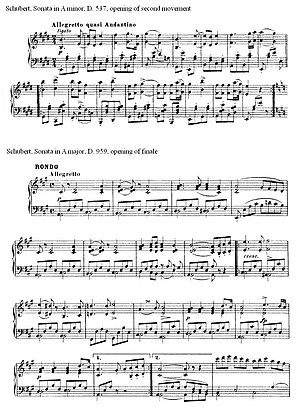Sonata allegro presentation. 1.
MUS 204- Section 1.1. Background The term sonata was a general word for instrumental music in the Baroque. This is “sonata” as a genre. The term sonata form (also sonata-allegro, sonata principle) generally refers to pieces in the classical era and beyond.
This is “sonata” as a formal pattern. Often the first work of Classical and Romantic sonatas and symphonies are in sonata-allegro form (“sonata” as genre and form). Sonata-Allegro grew out of the Da Capo aria and also the Rounded Binary form. These both have ABA structures. The Basic Outline Please refer to diagram in book. Three main sections: Exposition- introduces themes Development- elaborates/plays with themes Recapitulation- brings keys back together Themes are also called “tonal areas” and “groups.” The basic formal design is relatively similar between pieces. The interest comes in how the composer goes about fitting the piece into the form. The Exposition Introduces the Themes Group 1 (Theme 1, TA 1) is always in the tonic key area Group 2 is (Theme 2, TA 2) is in V in a Major key and III (sometimes v) in a minor key There is a transition or bridge in between the two groups that destabilizes the key There can be an introduction before the first key comes in The exposition typically ends at a repeat sign.

Haydn Piano Sonata No. 4 This exposition begins with the first group. There is no introduction. The first theme is on the next slide. It’s ends with the full G-major cadence in measure 7. Immediately following that is the beginning of the transition. First theme (ends m.

Notes
7) . Transition Transitions often start off like the original theme It can be tricky to identify exact boundaries of the transition Listen for a destablization of the key.
This is typically going to V or III, and often ends with a V/V. Haydn’s Transition Note it starts like theme, ends of V/V. Second Theme This will start in the secondary key area (V or III) It may have some similarities to the first group, but should be notably different. Think of the “B” section in a rounded binary form. By the end, there will be a strong cadence in the secondary key area. Haydn’s Second Theme It starts with the same descending figure, but is different in texture and key area It ends with a cadence in D (V).
Codettas Some (not all) Sonata forms have codettas at the end of the Exposition. Because we had an authentic cadence in the secondary key at the end of the second theme, and because the new section has a different texture, we can call this a codetta. Codettas (and codas) are closing sections that do not modulate, but merely act to extend the phrase or wrap up a section.
'Nobody writes better about music. Again and again, unerring insight into just the features that make the music special and fine.' — The New York Review of Books Charles Rosen says of sonata form: 'It is not a definite form like a minuet, a da capo aria, or a French overture; it is, like the fugue, a way of writing, a feeling for proportion, direction, and texture rather than a pattern.' Book Details. Paperback. August 1988. ISBN 978-0-393-30219-6.
6.2 × 9.3 in / 432 pages. Sales Territory: Worldwide Also by Charles Rosen. Expanded Edition / Paperback All Subjects.